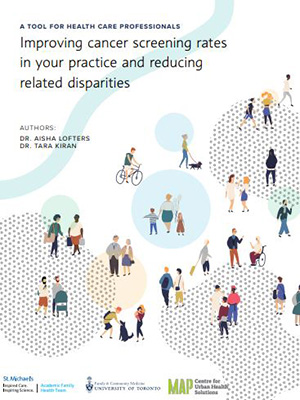A cancer-screening approach for patients, designed by patients

By Ana Gajic

Cover of report, Improving cancer screening rates in your practice and reducing related disparities
There’s no question that cancer screening can catch disease early, set people on a path to treatment sooner, and ultimately save lives. The question is how to ensure that everyone is accessing the screening they need.
Researchers at the MAP Centre for Urban Health Solutions have grappled with this question for years, focusing particularly on encouraging screening in communities experiencing disadvantage. In a study published today in the Journal of General Internal Medicine, they set out to find out why patients with lower incomes were less likely to be up-to-date on breast, cervical and colorectal cancer screening and what would be the best approach to bridge the gap.
“At the St. Michael’s Family Health Team, we have conducted several projects to increase overall screening,” said Dr. Aisha Lofters, a MAP scientist, family physician and lead author of the study. “Through previous work, we had already observed that among patients whose self-reported income was below the low-income threshold set by Statistics Canada, only 69 per cent were up-to-date on colorectal cancer screening compared to 75 per cent being up-to-date if their income was above the threshold.”
To find out what would resonate with patients, the researchers went straight to the source – their patients. They conducted 25 in-depth individual interviews and hosted three focus groups with patients who self-identified as having low income.
Two main barriers to screening emerged: fear and competing priorities. Patients feared the examination, the possibility of diagnosis, and the idea of triggering past traumas. Other physical ailments and social issues presented patients with competing priorities to staying up to date on cancer screening.
“To combat these issues, patients suggested outreach and communication using a friendly, encouraging tone – which we dubbed the ‘tea and cookies approach,’” said Dr. Tara Kiran, co-lead on the study and family physician.
This strategy includes friendly, knowledgeable phone calls as reminders for cancer screening and a group education strategy to engage patients who are behind on their screening. As for how to present information, patients encouraged the use of visuals and text in medical and plain language. Views on this type of outreach were not universal; for instance, women were more likely than men to favour group education.
“What this really showed us is that a multi-modal approach to cancer screening outreach is the most effective,” Dr. Lofters said.
Because of this study and its findings, the Family Health Team is now piloting group sessions where patients learn more about screening and wellness more generally; they also have the opportunity to get screened right then and there if they wish. For the pilot, their focus is on women overdue for at least two types of screening. A nurse and dietitian from the team lead the group sessions.
In addition, Dr. Lofters, Dr. Kiran and their team have developed a toolkit for other primary care providers who are looking to improve cancer screening rates and reduce disparities in care. That work is now available online for download.
“We can’t know what will resonate with patients, without engaging patients,” Dr. Kiran said. “Our practice will continue to prioritize patient input and co-design to create the best care experiences and outcomes.”
This paper is an example of how St. Michael’s Hospital is making Ontario Healthier, Wealthier, Smarter.
About St. Michael’s Hospital
St. Michael’s Hospital provides compassionate care to all who enter its doors. The hospital also provides outstanding medical education to future health care professionals in more than 27 academic disciplines. Critical care and trauma, heart disease, neurosurgery, diabetes, cancer care, care of the homeless and global health are among the Hospital’s recognized areas of expertise. Through the Keenan Research Centre and the Li Ka Shing International Healthcare Education Centre, which make up the Li Ka Shing Knowledge Institute, research and education at St. Michael’s Hospital are recognized and make an impact around the world. Founded in 1892, the hospital is fully affiliated with the University of Toronto.
About Unity Health Toronto
Unity Health Toronto, comprised of Providence Healthcare, St. Joseph’s Health Centre and St. Michael’s Hospital, works to advance the health of everyone in our urban communities and beyond. Our health network serves patients, residents and clients across the full spectrum of care, spanning primary care, secondary community care, tertiary and quaternary care services to post-acute through rehabilitation, palliative care and long-term care, while investing in world-class research and education. For more information, visit www.unityhealth.to.
